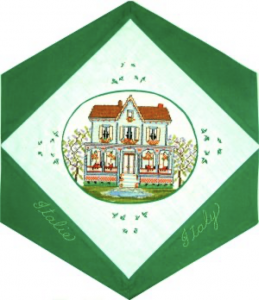Italy

The Block
This block is the result of a team effort by Maria Bonacci, Carmela Buda, Anna Chiappa, Pierina Costanza, Sandra Caccinelli, and Ariella Hostetter. It features a beautifully embroidered house, flanked by lilac trees, and fronted by a fish pond. The design inspiration comes from a well known song in Italy, Una Casetta in Canada. This song, one of the winners at the 1957 San Remo song festival, speaks of the dream of Italian immigrants to own their own home in Canada. On a surrounding background of fine linen, a white-on-white cutwork embroidery technique is used to create a design of grapes and leaves intertwined with swirling vines, symbolic of Italy’s prominent wine industry. Embroidered linens have long played an important role in the lives of many Italian women, who often learned this craft as young girls from nuns.Young girls used to embroider linens in preparation for marriage. Each girl needed to have forty-eight embroidered sheets and sets of pillow cases, as well as towels and various household items to complete her trousseau.
Cultural Profile
Home to some of the world’s most amazing architecture and art such as the churches of Florence, the Grand Canal in Venice and the Leaning Tower of Pisa, Italy is sometimes called the world’s ‘living art gallery.’ It has an extremely rich culture that has had a great and lasting influence on the development of western world. Literary, musical, and artistic achievements include works from writers such as Machiavelli, Dante, Alessandro Baricco and Umberto Eco; composers Vivaldi and Verdi; violin makers Stradivarius and Amati; and artists such as Michelangelo and Leonardo da Vinci. Italy’s cinema dates back to 1903. It has had a lasting influence on many genres from the ‘spaghetti westerns’ of Sergio Leone to the neorealist films of Visconti and Antonioni. The Cinecittà studios in Rome are considered one of the most significant production sites in history by movie buffs the world over.
The official language is Italian of which there are hundreds of different dialects. Italians often use gestures to emphasize their words and like to make use of their whole bodies when expressing themselves. They also enjoy incorporating proverbs and sayings into conversations to get certain ideas across. Italy was unified as a country during the 19th century from a collection of republics, kingdoms and dependencies. As a result, even though there is a strong national Italian identity, each region still possesses its own culture and traditions, proudly safeguarded by its inhabitants.
Historically, the family has always been a source of stability and strength and today it still remains very important. Italians take great pride in their traditional cuisine and meals are synonymous with quality time. Afterwards, it is common to go for a passeggiata, an evening stroll to visit with neighbours. Children have a special place in Italian society and are included in social events, while elders are valued and taken care of in their children’s home.
Italy is an important centre for fashion and industry. Furniture, appliances, household items and cars (Italy’s largest employer is Fiat), which are exported worldwide, are renowned for their innovative design. Wheat, the main cereal crop, olives and grapes are grown across the country, and used to produce other important exports, such as pasta, olive oil and wine.
Italy has a long tradition of fine craftmanship. Bobbin lace-making and needle lace have been developed over past centuries, with regional styles such as Genoese lace, Punto in Aria, reticella, or Point de Venise. Linens are still hand-woven in places like Umbria or Calabria. Italy is also known for its ceramics, glasswork, stylish leather shoes, apparel and furniture.
The first Italian to reach Canada was Giovanni Caboto (John Cabot) who arrived in Newfoundland in 1497. The original settlers that followed were disbanded soldiers in the 1650s, but Italian settlement here actually began in the 1880s with Italians coming to work in the mines and railway construction. Throughout the next century, the Italian population grew and many found work as stonemasons, green grocers, tailors and cobblers. Canadian cities, such as Montreal and Toronto, developed neighbourhoods known as ‘Little Italy,’ indicating that they were establishing a permanent presence in Canada. To date, many Italian associations and community centres have been created across the country, including the Comitato Attività Italiene in Vancouver, the Casa d’Italia in Montreal, and the Italian Community Hall on Cape Breton Island. Italians form the fourth largest ethnic group in Canada, numbering over 1,400,000 people. As such, they have greatly enriched the Canadian mosaic, sharing their skills as trades people, professionals, farmers, and artists, and their cultural traditions from foods to fashion to all fields of art.
Sponsor: Somerset West Community Health Centre, Gruppa Anziani
